Site menu:
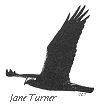
February 2011 Newsletter
Ramsar - 40th Anniversary.
January Bird News.
Forthcoming Events.
Latest Newsletter.
Ramsar - 40th Anniversary
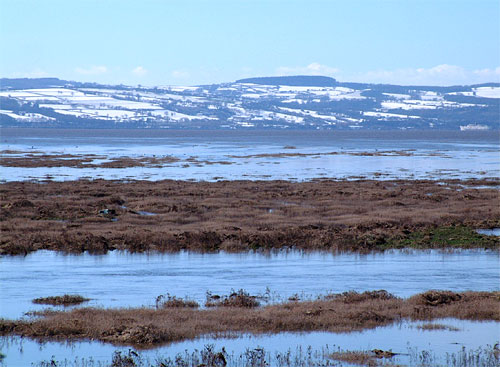
The Convention on Wetlands of International Importance was signed forty years ago, on Feb 2nd 1971, in the Iranian city of Ramsar - and is widely known as just 'Ramsar'. It is the only global environmental treaty that deals with a particular ecosystem - Wetlands. Ramsar's mission is "the conservation and wise use of all wetlands through local and national actions and international cooperation, as a contribution towards achieving sustainable development throughout the world". Currently a total of 160 countries have signed the treaty and have designated a total of 1,911 wetland sites including 168 in the United Kingdom - more than any other country. In 1971 this was a ground breaking treaty and was a forerunner for legislation such as the EC Habitat Directive from which Special Protection Areas and Special Areas of Conservation followed. World-wide Ramsar has been immensely important; among other things raising awareness of the importance of Wetlands, changing peoples attitude to them and altering their behaviour when using wetlands so that they can be used sustainably for the benefit of both man and wildlife.
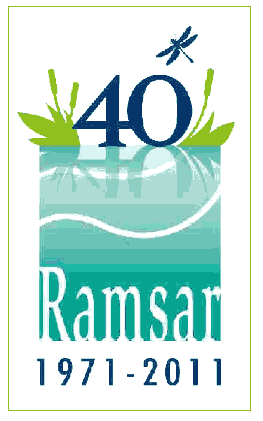 The Dee Estuary was designated a Ramsar Wetland of
International Importance on Jul 17th 1985. The Ramsar secretariat has been
quite active here since then with the visit of Advisory Missions in 1993
and 1994 as a result of which the Dee Estuary was put on the Montreux
Record. Basically this means it was regarded as an area of concern due to
various threats; these included construction of the Connah's Quay Power
Station, the possibility of a Flint by-pass over the salt marsh, dumping of
colliery waste, cockling, dredging and general recreational disturbance.
Some of these threats no longer apply, didn't materialise or weren't as
harmful as feared. Inevitably some threats remain and new ones have arisen
since 1994, but we are lucky to have people like the RSPB, the
Dee Estuary
Conservation Group, Dee Estuary Voluntary Wardens
and the local Countryside Ranger Services to deal with these
and educate the public. Just making people aware of the estuary and
it's fantastic wildlife makes all the difference.
The Dee Estuary was designated a Ramsar Wetland of
International Importance on Jul 17th 1985. The Ramsar secretariat has been
quite active here since then with the visit of Advisory Missions in 1993
and 1994 as a result of which the Dee Estuary was put on the Montreux
Record. Basically this means it was regarded as an area of concern due to
various threats; these included construction of the Connah's Quay Power
Station, the possibility of a Flint by-pass over the salt marsh, dumping of
colliery waste, cockling, dredging and general recreational disturbance.
Some of these threats no longer apply, didn't materialise or weren't as
harmful as feared. Inevitably some threats remain and new ones have arisen
since 1994, but we are lucky to have people like the RSPB, the
Dee Estuary
Conservation Group, Dee Estuary Voluntary Wardens
and the local Countryside Ranger Services to deal with these
and educate the public. Just making people aware of the estuary and
it's fantastic wildlife makes all the difference.
Cockling is a good example of just what can be achieved. In the 1990s there was a free for all of uncontrolled cockling in the Dee Estuary with tractors and quad bikes being driven all over the mud flats causing large amounts of disturbance and damage, a similar situation to what happened at Leasowe on North Wirral this winter. It took a long time and a lot of hard work but in 2008 the Dee Estuary Cockling Regulation Order came into place which strictly limits the number of licenses (which can be revoked if rules are broken), vehicles aren't allowed on the mudflats and the amount of cockles taken is strictly controlled - importantly all this was done with the cooperation and agreement with the cocklers themselves. The result of which is a sustainable fishery with virtually no negative impact on the estuary, it's wildlife or other user's of the estuary - contrast that with what happened at Leasowe where the Cockling Order doesn't apply!!
One last thing about Ramsar. One of the recommendations made by them in 1994 was to include Red Rocks SSSI, Dee Cliffs SSSI (at Thurstaston), Inner Marsh Farm, Talacre Warren and Gronant Dunes within the Dee Estuary Ramsar site. In the past couple of years all these sites have been included both within the Dee Estuary Ramsar site and the SPA (Special Protection Area), thus giving them the same protection from development etc. as the rest of the estuary.
As part of the 40th anniversary celebrations for Ramsar February 2nd 2011 has been designated World Wetlands Day - here on the Dee Estuary the RSPB are having a special Point of Ayr Birdwatch on that date, click here for details.
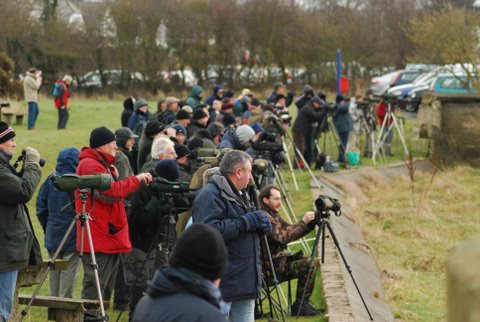
© Harry Lyon.
For more information on Ramsar see www.ramsar.org.
Richard Smith
January Bird News
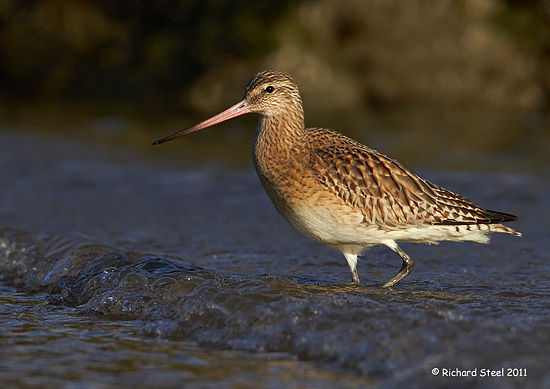
So much happened in January it's difficult to know where to start - and that's despite the weather going much milder!
Icing on the cake was a sprinkling of rarities, here they are in date order. The 6th was a particular good day with two Shorelarks on Middle Eye (also seen on 8th on West Kirby Shore), two Velvet Scoters past Hilbre (also seen off Leasowe on 23rd), a Great Northern Diver off Hilbre and Green-winged Teal at Inner Marsh Farm, the latter then recorded on several more days through the month. An Avocet was on West Kirby Shore on the 7th but was unfortunately killed by crows the following day. The 8th saw a Red-necked Grebe and another Great Northern Diver off Hilbre. A Water Pipit was at Neston Old Quay on 9th. A Red Kite flew out from Mostyn on the 17th. Two Twite were in a Linnet flock at Heswall on 23rd and 24th. Two Cetti's were in a scrub area just south of Neston reedbed on 29th followed by a single heard the next day.
Regular readers of this newsletter will know about the large flocks of Great Crested Grebes found off North Wirral, one of the biggest in the country (see December 2010 newsletter). You will see from the graph below that the count from Hoylake Shore of 1,195 on Jan 20th almost doubled the previous record of 604! It was one of those perfect days for counting birds on the sea - sunny, flat calm and clear with a high tide. Jane Turner, whose count it was, also had the advantage of being able to count from the third floor of her sea-front house. I'd be surprised if this wasn't the highest or second highest count in the country for this winter. There was another high count on the last day of the month with 697 off Leasowe Lighthouse.
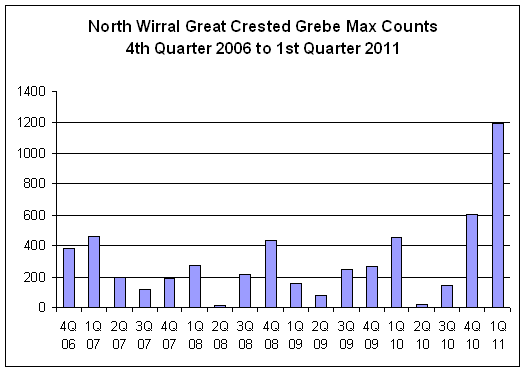
Also seen off Leasowe Lighthouse, but much closer to the shore, were a flock of Scaup reaching a max of 96 on the 31st, a really good count for a species which has become quite scarce in the area in recent years.
Although we can get flocks of many hundreds of Pink-footed Geese passing through the estuary between Norfolk and south Lancs, it is probably not since the beginning of the 20th century when we last had such good numbers spending the winter here - max of 1,685 feeding on Shotwick Fields on the 8th. Mostly they were to be seen on the marsh and during the high tides of the 22nd/23rd parties were ranging all the way between Burton and Heswall. Another goose species was also very much in the news, with a record count of 212 pale-bellied Brent Geese just off the marsh at West Kirby on the 23rd - counted by four experienced WeBS counters. Over the past few years a pattern has emerged whereby there is a sudden and usually quite short-lived peak in numbers for Brent around the third week in January.
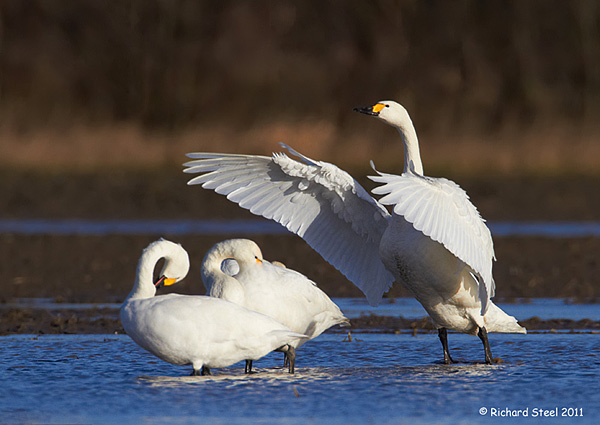
Swan numbers have also been high. From reports received they seem to have been exclusively on the Shotwick Fields, rather than Burton Marsh where many used to occur a few years ago. I know from personal experience it is difficult to count the Bewick's and Whoopers separately as more often than not about half the birds seem to have the beaks hidden! I've not seen any 'official' counts but the highest that I have received are a max of 100 Whooper Swans and 174 Bewick's Swans, both of which may well be record high Dee Estuary counts for both species!
Gull numbers were high on Hoylake Shore during the spring tides. Numbers of Herring Gulls started to build on the 19th with 4,060 peaking at 7,500 by the 24th when 5,000 Black-headed Gulls were also present. Although these are high numbers and unusual for January several higher counts have been made from Hilbre over the years. Also present over the same period were a couple each of Mediterranean and Yellow-legged Gulls.
When the mild weather arrived it was noticeable that most of the Knots seemed to disappear whereas Dunlin increased - intriguing movements! As soon as the weather got colder at the end of the month Knot numbers increased again with 18,000 Knot off Thurstaston on the 31st. Max Dunlin count was 9,000 at Hoylake on the 5th. Black-tailed Godwit numbers also decreased with the mild weather, I suspect many went to Marshside RSPB, then returned to over 2,000 at Thurstaston by the end of the month. 21 Purple Sandpiper on the pontoon at New Brighton Marine Lake on the 10th was the highest count.
Two Marsh Harriers have been present and a max of five Hen Harriers; an adult male, a sub-adult male and three ringtails.
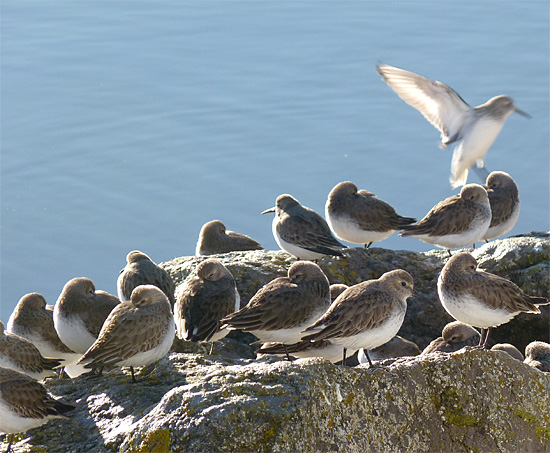
Richard Smith.
What to expect in February
We get the first signs of spring this month (hopefully!!) with a lot of bird song in woods and gardens on sunny days, plus Sky Larks singing on the marshes and woodpeckers busy drumming. A rare songster may well be a Cetti's warbler or two, the Neston Old Quay area seems to be the best place for these. There may well be signs of spring out at sea as well, given a mild south-west wind we could get our first Gannets and Little Gulls of the year, and any Mediterranean Gulls seen should be beginning to turn into breeding plumage.
Perhaps the most exciting thing to look forward to this month are the big tides on 19th to 21st (see Forthcoming Events below for details). Given a west wind we should see the tide cover the marsh flushing plenty of birds. Short-eared Owls have been in short supply this winter but there is often a late winter influx of these and I fully expect to see several during these tides, along with Water Rails and both Hen and Marsh Harriers plus the usual duck and waders. As usual the best places to see the tide will be Parkgate Old Baths, the shore path going from there by Heswall Golf club going towards Gayton and the Heswall Riverbank Road Car Park. On the Welsh side the Connah's Quay Reserve and Point of Ayr should be prime spots.
February 6th last year saw a large movement of Pink-footed Geese moving from Norfolk to south Lancashire with many hundreds passing through Cheshire including the Dee Estuary - a spectacular sight. Chances are we won't get as many this year but even so it is certainly worth looking out for. In addition to this movement we also have an increasing resident flock of 500 to 1,500 and they seem to spend their time either on the marshes between Burton and Heswall or on Shotwick Fields with the wild swans.
Given another cold spell we should still have good numbers of waders around including rarer ones such as Spotted Redshank, and Purple Sandpipers usually peak this moth - look for them on Hilbre and at New Brighton.
Forthcoming Events
February Highest Spring Tides (Liverpool)
Also see
Tides page.
19th February, 11.41hrs (GMT), 10.0m.
20th February, 12.23hrs (GMT), 10.2m.
21st February, 13.06hrs (GMT), 10.1m.
Forthcoming Events
Organised by the
Wirral Ranger Service ,
Flintshire Countryside Service and/or the RSPB:
All these events and walks have bird interest, even those not advertised
specifically for birdwatching. No need to book for these events unless
specified - please check below.
Also see 2011 Events Diary.
Wednesday 2nd February. Point of Ayr Special, see 'poster' at bottom of the page.
Friday 4th February 9am start, Track the Tide.
Join the Coastal Rangers on a walk along
Thurstaston Shore towards Heswall following the rising tide. The rising
water will move the waders and wildfowl from their feeding grounds towards
their marshy roosts providing great wildlife-watching opportunities. Bring
binoculars and wear sturdy shoes and warm waterproofs. No need to book,
meet at the Wirral Country Park Visitor Centre.
For further ino call (0151) 648 4371.
Friday 4th February, doors open at 7.30pm for 7.45pm start, 'THE
BLACK-TAILED GODWIT’ by Dr Jennifer Gill, indoor talk at Knutsford for
CAWOS.
The talk is based on the
large-scale and long-term study of Icelandic Black-tailed Godwits over the
last 12 years. Individual colour-marking of this population, and the wide
network of volunteer observers across Europe, has allowed us to better
understand the links between habitats of varying quality, summer and winter,
with profound implications for the species.
The meetings will be held in the Cranford Suite (situated behind the
cinema), Civic Centre, Toft Road, Knutsford, WA16 0PE. An entrance fee of
£2.00 to members and £4.00 for non-members will be charged. A coffee break
is taken halfway through the evening. The doors open at 7:30pm for a 7:45pm
start (for some local background information on this study see the
Colour-ringed Black-tailed Godwits article in the Jan
2011 newsletter on this website).
Saturday 5th February, 9.30am start (HT@12.30pm, 9.3m),
Flint High Tide Bird Watch.
We will be focusing on the 1000's of waders and wildfowl coming in to roost
on this very important part of the estuary. Flocks of finches are common
feeding on seeds and last year’s twite were an excellent addition to a
thoroughly enjoyable walk across a fascinating landscape.
Phone 0151 336 7681 or email
deeestuary@rspb.org.uk for further details.
Saturday 12th February 9:00 am until 3:00 pm. Low tide Birdwatch on
Hilbre.
Join the Rangers and staff from the RSPB for a low tide visit to Hilbre
Island. Among the usual species of wading birds, we should encounter Brent
Geese, Purple Sandpipers and also good numbers of Turnstones. Warm clothing
and suitable footwear are essential. Sorry no dogs. Please book early as
there are limited places available. For booking and further enquiries call:
0151 648 4371.
Sunday 13th February - 3pm start, Parkgate
RSPB Raptor Watch.
The Dee Estuary Nature Reserve is a vital wintering grounds for many birds
of prey – Discover these impressive birds in their wild habitat, hunting
and roosting on the saltmarsh. Warm clothing and binoculars are
recommended. Call 0151 336 7681 for further details.
Saturday 19th February, 10am start, Marsh Magic at
Riverbank Road, Heswall.
Join the Coastal Rangers at Riverbank Road car park in Lower Heswall for a
high tide birdwatch. With a predicted height of 10.0m the marsh could
flood, providing great views of waders, wildfowl and raptors. High Tide
11.41am.
Wear warm waterproofs and bring binoculars.
For more info call (0151) 648 4371.
Saturday 19th February, 10am start. RSPB Parkgate High Tide Birdwatch. High Tide 11.41am, 10.0m.
Join RSPB wardens to watch the tide rise and hopefully cover the entire saltmarsh at Parkgate. Keep an eye out for the reserve's usual suspects,
such as Short-eared Owls, Hen Harriers, Peregrines and Merlins, as well as hopefully
seeing some of the more secretive species of birds and mammals as they are
forced out by the rising tide. Meet at Old Baths Car Park, Parkgate.
Ring
0151 336 7681 for further info.
Sunday 20th February, 11am start. RSPB Parkgate Tide Birdwatch.
High Tide 12.23am, 10.2m.
Details as above.
Monday 21st February, 11.30am start. RSPB Parkgate High Tide Birdwatch. High Tide 1.06pm, 10.1m.
Details as above.
Saturday 5th March 9:30 am until 12 noon. Birdwatch at
King’s Gap Hoylake.
Join the Dee Estuary Voluntary Wardens, Rangers and staff from the RSPB to watch the birds as they roost
and feed on the incoming tide. Warm clothing and suitable footwear are
essential. No need to book.
Sunday 13th March, - 4pm start, Parkgate RSPB Raptor Watch.
The Dee Estuary Nature Reserve is a vital wintering grounds for many birds
of prey – Discover these impressive birds in their wild habitat, hunting
and roosting on the saltmarsh. Warm clothing and binoculars are
recommended. Call 0151 336 7681 for further details.
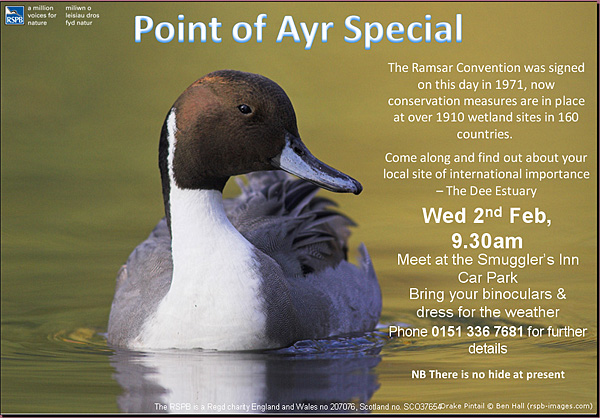
|
 |
The blank (UK) Birding Webring is a collection of quality birding web sites that are based in the United Kingdom. Visit the webring homepage for more information, or A complete list of all the sites in the webring is available by clicking here. previous site in ring : random site in ring : next site in ring |